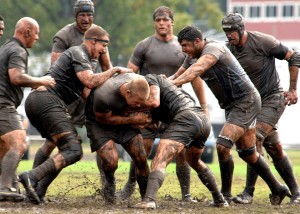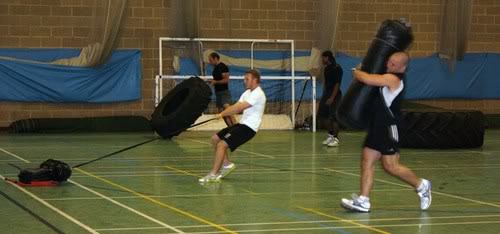 For one of John Pryor‘s rugby players, having an abundance of strength and power is beyond helpful. It’s essential. As you might have noticed, rugby is a very fast-paced, rough, and rugged game. Therefore, building adequate strength via sustained strength and endurance training are imperative parts of every rugby player’s workout regimen. The majority of rugby skills are time-constrained, happening at high speeds with high physical stakes at hand. With that said, strength and hypertrophy are only the building blocks of a sturdy rugby player. For full functionality, both power and speed are needed in order to shape a rugby player, and that can’t come without extensive strength training.
For one of John Pryor‘s rugby players, having an abundance of strength and power is beyond helpful. It’s essential. As you might have noticed, rugby is a very fast-paced, rough, and rugged game. Therefore, building adequate strength via sustained strength and endurance training are imperative parts of every rugby player’s workout regimen. The majority of rugby skills are time-constrained, happening at high speeds with high physical stakes at hand. With that said, strength and hypertrophy are only the building blocks of a sturdy rugby player. For full functionality, both power and speed are needed in order to shape a rugby player, and that can’t come without extensive strength training.
Every Player is Different, But Strength Reigns Supreme
Your position, your own personal style of playing, as well as your team’s style, may dictate the amount of training needed in each area. Speaking from experience though, there’s no short of strong, well-trained players in even the lower levels of the professional game. Besides maybe a further understanding of the game and the development of specific sets of skills; the key aspects separating the top-level pros and international players from the rest is pure strength and power in its rawest form.
Building Agility on a Muscular Frame
With all of that being said, I think that it is very agreeable that speed and power are very specific abilities, whereas strength and hypertrophy are more general in nature. Heavy strength training should be focused on more heavily in the earlier stages of the athletes career, building bulk muscle and preparing for the season, with the more specific muscle training and skill training coming later on. After you’ve built sufficient muscle memory, adding agility to the mix will be much easier and less risky.
Preventing Overtraining and Preparing for the Season
Rugby athletes shouldn’t concern themselves too deeply with their strength and size as long as they have a solid training foundation. You should start with a good 4-8 week training block in the earlier parts of the pre-season, during which you’d be almost exclusively weightlifting to add mass. After that, reduce the weight used in your workout to a minimal and focus on high reps and aerobic activities, focusing on slowly increase speed while maintaining maximum power in all movements. Many rugby players continue to build mass through strength training for many years after they’ve entered a professional or amateur league.
Core Strength and Durability Counteract High Injury Risk
In the game of Rugby, as many as 1 out of every 4 players will be injured during a season; which is three times the injury rate that soccer has. Around 40% of rugby injuries will be muscular strains or contusions (bruising of the muscle). About 30% of the injuries will be sprains, then followed by fractures, dislocations, lacerations, and also over-use injuries. With those statistics said, it is obvious why it is important, in the game of Rugby, to have overwhelmingly adequate strength that comes from training towards fine-tuned power, speed, and precision.
 There are many reasons the John Pryor strength and conditioning principles for rugby training have generated such an impressive degree of success for the Japanese national team, with many pointing to the deciding scrum occurring during injury time against the heavily favored South African squad in World Cup play as evidence of the incredible impact of what could accurately be described as the John Pryor rugby training approach. While Pryor would be very likely to point out the many factors that go into any athletic team’s success, he has outlined some of the key principles used in the team’s training program that very likely played a significant role in the Japan Rugby Football Union’s surprising ascent.
There are many reasons the John Pryor strength and conditioning principles for rugby training have generated such an impressive degree of success for the Japanese national team, with many pointing to the deciding scrum occurring during injury time against the heavily favored South African squad in World Cup play as evidence of the incredible impact of what could accurately be described as the John Pryor rugby training approach. While Pryor would be very likely to point out the many factors that go into any athletic team’s success, he has outlined some of the key principles used in the team’s training program that very likely played a significant role in the Japan Rugby Football Union’s surprising ascent. For one of
For one of 